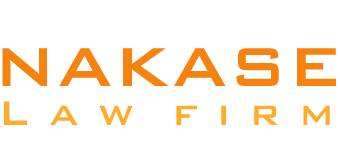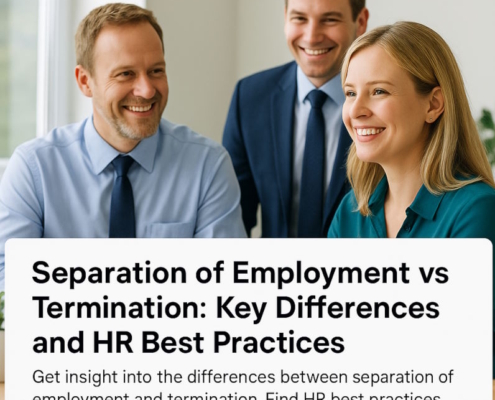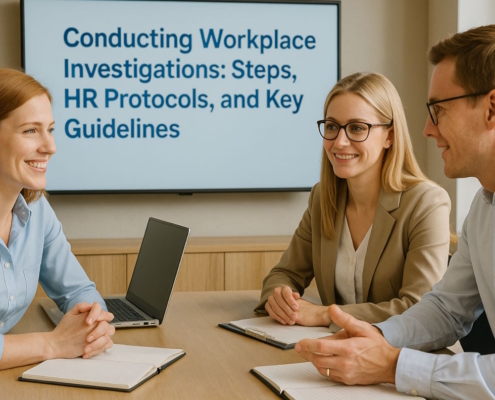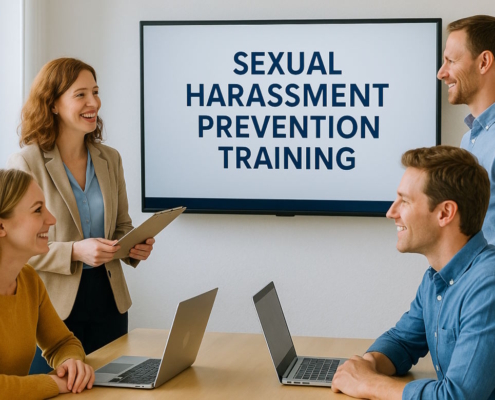Introduction
HR specialists should be fully comprehensive regarding how workplace investigations should be carried out. Workplace investigations are certainly conducted when an employee contacts to report significant wrongdoing by a coworker.
Doing a workplace investigation has become essential for preserving a positive workplace culture in the fast-paced workplace of today, where employees are more aware of their legal entitlements and employers are constantly being watched. Additionally, without an investigative interview, the workplace investigation procedure for the majority of employee-related incidents would not be comprehensive.
An organization may experience a wide range of effects from assuring legal compliance to raising employee engagement and morale as a result of a workplace investigation. Continue reading to discover important knowledge and approaches for maintaining a productive and legal workplace through improved HR investigations.
Workplace Investigations Synopsis
Workplace Investigations are used when an employee has broken a policy or acted inappropriately. It involves the acquisition of data and corroborative records. The employee relationships team should ensure that there is compliance with labor relations, employment laws, and internal regulations at all levels of the process. It could be a straightforward verbal conversation with staff members or a more involved investigation.
Workplace investigations can be started for a number of reasons, including the following, and are essential for preserving a respectful and safe workplace for employees:
- Any kind of intimidation
- Discrimination
- Abuse of substances
- Threatening or using violence against other people
- Vandalism or theft
- A conflict of interest
- Betrayal of confidence
- Abusing sick leave
- Too much absenteeism
- Additional infractions of business regulations
Conducting Workplace Investigations and Harassment Investigations: The Difference
Investigations involving harassment are similar to those concerning other workplace issues. It requires a specialist approach since they are sensitive. The analysis of harassment at the workplace focuses on the unwanted or offensive conduct directed at an individual or a group of people due to the characteristics that are protected (gender, color, religion, or handicap).
Such studies also require a profound understanding of relevant laws and regulations. It also entails the ability to create a safe and stimulating atmosphere for the participants. It might be that there is a necessity to maintain the privacy of all concerned individuals. Conducting workplace investigations may frequently require secrecy. Successful implementation of these specialist investigations requires the investigators to be trained accordingly. They ought to possess a straightforward communication strategy and commitment towards developing a harassment free workplace.
Workplace Investigations: Why and when to carry them?
Not all office conflicts or miscommunications would require a formalized workplace investigation. In some cases, the party complaining and the other party will agree on what has happened. A simple talk to the concerned individual will resolve the situation. In case the issue appears to be more of incivility or character than serious misconduct, then you might conclude that a formal investigation is not necessary. Corporate rules may be misunderstood, or there may be a breakdown of communication. An informal talk would be the most appropriate.
An official investigation should be initiated immediately in case of doubt. Lack of investigation could lead to both legal problems and continuity of problems in the workplace, which can slow down productivity. The problem can become even graver than it appeared. The number of questions asked can be a good way to determine the frequency or seriousness of a problem.
Conducting workplace investigations is mandatory whenever:
- An official complaint is submitted.
- There is a violation of a workplace policy.
Don’t take too long to determine whether or not an official investigation is required. Due to the employer’s tardy, insufficient, or improper response to a complaint, jurors have frequently granted plaintiffs enormous sums of money.
Time taken for doing an HR investigation
Having the aim to restrict the harm to the staff members and the firm itself, and not letting the facts of the incident get lost with time, the investigations need to be completed as quickly as possible. Nevertheless, the intensity of the issue may also influence the duration of the workplace investigation. Whereas some circumstances may be completed in a short period of time, some may span weeks and even months. The complexity of the research associated with the case may demand that it start as soon as possible.
Conducting Workplace Investigations
The method of conducting a workplace investigation should be carefully planned. Relevant information has to be collected and analyzed objectively. Your team can ensure that a fair conclusion is reached by following the standard guidelines and rules.
Employee perceptions of the reliability of the workplace investigation procedure can be distorted. They could think that HR experts are working toward a particular outcome that benefits the business. Employing a consistent approach is essential. It shows that your company has a methodical procedure in place to handle these circumstances in a reasonable & trustworthy manner.
Are you able to carry out impartial HR probes in the workplace? It must comprise a well-structured interview process. Here are eight critical steps for conducting workplace investigations that can help you use the potent fact-finding value that is implied in a well-conducted assessment:
- If you have to, act right now
The first stage in conducting a successful and equitable HR investigation is figuring out whether something needs to be done right away, like sending a disruptive worker home for a while or adjusting schedules to avoid future disputes.
- Assign an investigator
Take care while selecting an investigator to guarantee objectivity. Find a good colleague who is not personally involved in the issue. You may also think about enlisting outside assistance.
- Decide on the scope and create a strategy
The following are included in this stage of the workplace investigation process:
- Describing the precise problem or occurrence under investigation, together with the policy or policies that may have been broken.
- The participants.
- Investigation schedule.
- Gathering information about the event (place, date, and names of witnesses).
- Other relevant documents, emails, or records.
There is a lot of preparation required in carrying out successful interviews. It involves determining who to interview and at what time.
The human resources or the individual tasked with the investigative interview has to interview both the person who is bringing the issue, as well as the person being accused of misconduct, so that facts behind any allegation of worker misconduct can be properly and fairly established. The investigator must find out the existence of any witnesses, and in case they exist, he should interview them.
As a rule, we recommend that the individual filing the complaint, the accused, witnesses, and the complainant be interrogated, respectively. This lets you use information from the interviews to reexamine their initial story. Each case is unique and must be evaluated in light of the accusation.
You should consider the research questions you will pose to the interviews. Human resources can construct a standard set of questions to ask in workplace investigation interviews to level the playing field. Key interview questions will ensure the interviewers use a just approach to the interview. The conduct will be all-inclusive fact-finding.
- Interview people
Interviews are essential to a just conclusion in workplace investigations. When done correctly, they may disclose significant information and justify a colleague in their accusations of wrongdoing. When done in the wrong manner, they may yield huge consequences to the business in terms of huge losses, settlement of back pay, or even total reinstatement of an employee.
The interview must start with an introduction of every participant. You should mention the general description of the purpose of the interview. An articulation of the truthfulness and sincerity that you expect everyone to respond to the questions with is important. This provides the criteria and demonstrates that all people are treated equally.
Well-formulated questions will help in finding the truth. You cannot get much with questions that take “yes” or “no” as answers. The best thing to do is to ask general and not threatening questions, then proceed to ask specific ones. Michael Wade Johnson, the CEO and founder of Clear Law Institute, suggests employing a casual conversational technique to entice interviewers to open up in an SHRM post on spotting falsehoods and fraud.
Additionally, he recommends asking interviewers to narrate their tale backward, from beginning to end. This is simple if the subject is speaking honestly, but more challenging if they are following a script that they have memorized.
One effective technique to review and confirm the facts for more accuracy is to pose follow-up questions or reword existing ones. You should compare the respondents’ statements with any supporting data (emails or additional documentation).
One should also keep in mind that the actions and words of interviewees are equally eloquent as their words. It is easy to tell when the interviewee is lying by keenly observing how these individuals behave, and when is the right time to extend the probe.
- Reach a conclusion
Conclusion can include:
- Disciplinary measures
- Termination of employment
- Redistributing responsibilities
- Coaching or training
- A modification to workplace rules and regulations
Examine closely whatever information you have on comparable or identical cases in your company and how issues were handled to assist in guaranteeing equitable and consistent repair. For instance, you might expose yourself to potential legal action if you fired an executive for making similarly offensive remarks after suspending a manager for making sexist remarks in the past.
HR and management are required to uphold the rights of the employees throughout this process. If an employee is wrongfully accused of misbehavior, the employer ought to take action to erase their name and protect their image. This may occasionally entail paying for any injuries/losses sustained as a consequence of the inquiry.
Keep a record of your findings. Highlight the corrective measures you take. It is regardless of what you ultimately decide. This demonstrates that you performed adequately and fairly.
- Make a report
Doing the correct thing throughout an investigation is insufficient. Additionally, you must demonstrate it by maintaining thorough and understandable documentation at all times. A case file for a workplace investigation that can be defended should contain:
- A thorough investigation report
- Reasonable and authentic interview notes
- supporting paperwork that includes locations, dates, and names
- The steps you plan to take
A proper record of the whole investigation is provided by having the appropriate paperwork. Additionally, it exhibits procedural justice, safeguarding your company from lawsuits.
- Discuss the outcomes
The results of the investigation should be made known to all the parties. Managers must be cautious to inform results in a direct and dignified way. They are not to disclose any personal details. They must also be ready to respond to any questions/issues that come up during the inquiry. They may come from the staff members who may be directly or indirectly involved with any consequences of the findings.
The findings of a workplace investigation might lead to litigation, especially when the accused or complainant feels offended by the investigation or the employer has not acted in a just manner. Instances of this may include cases where you have to seek your own legal counsel.
- Aftercare
Aftercare in cutting-edge roles extends beyond risk reduction to prevent reprisals. Rather, it is given the same weight as the actual investigation and affects all those affected by the situation, regardless of whether the accusation was true or not. After all, each participant experiences an impact and leaves with a distinct perspective on the event and process. Aftercare is the most important period when you can build or destroy trust with the various layers of people involved.
Checking in with everybody one month after the closing and then at scheduled intervals throughout the year is one of the best practices. They consist of training or other initiatives that candidly confront issues at work. Documenting the efforts is one of them. Last but not least, they offer forecasting tools to ensure that you fulfill your commitments.
Four Best Practices for Equitable HR Investigation Procedures
- Inform the individual of the purpose of the interview
The interviewer should clarify the reason why the interview is being done and the grounds of the complaint to the interviewee prior to the commencement of the interview. In most cases, it is not appropriate or even recommended to share certain information with the witness concerning the accusation. Assure the employee that, due to the necessity to preserve the confidentiality of all parties concerned, you may not be able to provide all the information that you require to respond to questions regarding an incident occurring in the workplace.
You can also choose to ask the accused questions during the interview later, as opposed to letting them know that they are the subject of the complaint. On the other hand, they must have the chance of having their case heard. To do so, the relevant information about the allegation must be provided. A workplace investigation is an exercise in gathering facts, and the interviewer’s main role is to pay attention and pose questions rather than to provide the interviewee with data.
- Follow the HR investigation protocol set forth by your organization
A workplace investigation procedure should be spelled out in detail in the HR rules and procedures of every company. These rules will occasionally outline the prerequisites for an investigative interview. Usually, only specific managers or HR specialists are considered qualified to perform an investigation interview. Internal investigations have to adhere to business policies; all pertinent workplace investigation procedures must be followed prior to conducting any interviews.
- Do not postpone the probe
In the event that the employee who made the misconduct charge decides to take the matter to court, the courts will consider how quickly the workplace investigation was completed and if the interviews were done on time.
The purpose of conducting workplace investigations in a timely manner is to make sure that both parties can recall the facts as precisely and completely as feasible. An accuser or complainant in the misbehavior allegation can be away on a vacation or other planned leave. HR should make sure that meetings are set up as soon as they return. The explanations for the holdup should be noted.
- Keep a record of everything
Accurately recording the facts in a safe, compliant, and consistent manner is essential from the outset of an inquiry. Details that seem unimportant at the time, like the date and place of the interview and a sign of the fact-finding procedures that were carried out, can subsequently prove vital, even though some fact-finding is evident, like the specifics of the complaint.
Additionally, the notes must be readable, preferably in an employee affairs software program.
Standardizing the way you record and preserve dynamic information that frequently changes, such as job titles, work locations, team members, and direct managers, is one of the best practices. It is easier to prevent unintentionally erasing or losing evidence when this material is promptly preserved in a case management system.
Necessity of an HR Investigation Procedure
Every workplace incident is different. You must set up clear and consistent procedures for an impartial assessment. There are several ways that a lack of a suitable process might endanger your business. A careless investigation could expose you to liability in addition to possibly leading to the incorrect course of action.
Dissatisfied employees can bring legal action against your company. Any deficiencies in your investigation procedures can result in massive losses. Setting the rules of how unbiased HR investigations should be also informs your employees that the company does care about their rights and attempts to make the working environment secure for everyone.































